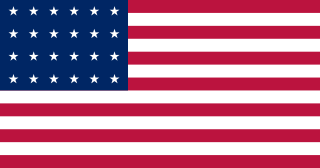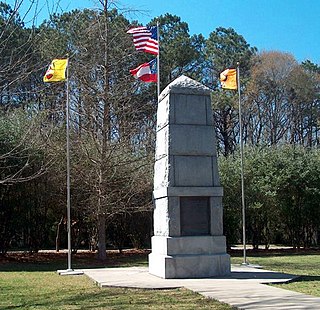
The Indian Territory and the Indian Territories are terms that generally described an evolving land area set aside by the United States Government for the relocation of Native Americans who held aboriginal title to their land as a sovereign independent state. In general, the tribes ceded land they occupied in exchange for land grants in 1803. The concept of an Indian Territory was an outcome of the US federal government's 18th- and 19th-century policy of Indian removal. After the American Civil War (1861–1865), the policy of the US government was one of assimilation.

The Trail of Tears was part of the Indian removal, an ethnic cleansing and series of forced displacements of approximately 60,000 Native Americans of the Five Civilized Tribes between 1830 and 1850 by the United States government. Removal for this event was gradual, occurring over a period of nearly a decade. Members of the so-called Five Civilized Tribes—the Cherokee, Muscogee (Creek), Seminole, Chickasaw, and Choctaw nations —were forcibly removed from their ancestral homelands in the Southeastern United States to areas to the west of the Mississippi River that had been designated Indian Territory. The forced relocations were carried out by government authorities after the passage of the Indian Removal Act in 1830. The Cherokee removal in 1838 was brought on by the discovery of gold near Dahlonega, Georgia, in 1828, resulting in the Georgia Gold Rush.
The Shoshone or Shoshoni are a Native American tribe with four large cultural/linguistic divisions:

An Indian reservation is an area of land held and governed by a federally recognised Native American tribal nation which government is accountable to the U.S. Bureau of Indian Affairs and not to the state government in which it is located. Some of the country's 574 federally recognized tribes govern more than one of the 326 Indian reservations in the United States, while some share reservations, and others have no reservation at all. Historical piecemeal land allocations under the Dawes Act facilitated sales to non–Native Americans, resulting in some reservations becoming severely fragmented, with pieces of tribal and privately held land being treated as separate enclaves. This jumble of private and public real estate creates significant administrative, political and legal difficulties.

The Dann Sisters, Mary Dann (1923–2005) and Carrie Dann (1932–2021), were Western Shoshone elders who were spiritual leaders, ranchers, and cultural, spiritual rights and land rights activists. They challenged the federal government over uses of their tribe's traditional land, in a case that reached the United States Supreme Court as U.S. v. Dann.

The Western Shoshone comprise several Shoshone tribes that are indigenous to the Great Basin and have lands identified in the Treaty of Ruby Valley 1863. They resided in Idaho, Nevada, California, and Utah. The tribes are very closely related culturally to the Paiute, Goshute, Bannock, Ute, and Timbisha tribes.

The Fort Laramie Treaty of 1851 was signed on September 17, 1851 between United States treaty commissioners and representatives of the Cheyenne, Sioux, Arapaho, Crow, Assiniboine, Mandan, Hidatsa, and Arikara Nations. The treaty was an agreement between nine more-or-less independent parties. The treaty set forth traditional territorial claims of the tribes as among themselves.
United States v. Sioux Nation of Indians, 448 U.S. 371 (1980), was a United States Supreme Court case in which the Court held that: 1) the enactment by Congress of a law allowing the Sioux Nation to pursue a claim against the United States that had been previously adjudicated did not violate the doctrine of separation of powers; and 2) the taking of property that was set aside for the use of the tribe required just compensation, including interest. The Sioux have not accepted the compensation awarded to them by this case, valued at over $1 billion as of 2011.
The Treaty of Ruby Valley was a treaty signed with the Western Shoshone in 1863, giving certain rights to the United States in the Nevada Territory. The Western Shoshone did not cede land under this treaty but agreed to allow the US the "right to traverse the area, maintain existing telegraph and stage lines, construct one railroad and engage in specified economic activities. The agreement allows the U.S. president to designate reservations, but does not tie this to land cessions."
The Indian Claims Commission was a judicial relations arbiter between the United States federal government and Native American tribes. It was established under the Indian Claims Act of 1946 by the United States Congress to hear any longstanding claims of Indian tribes against the United States. It took until the late 1970s to complete most of them, with the last case finished in the early 21st century.
United States v. Shoshone Tribe of Indians of the Wind River Reservation in Wyoming, 304 U.S. 111 (1938), was a United States Supreme Court case in which the Court held that mineral rights on a reservation belonged to the tribe, not the federal government.
United States v. Sandoval, 231 U.S. 28 (1913), was a United States Supreme Court case deciding whether the federal government's law prohibiting liquor on the land of Santa Clara Pueblo impermissibly infringed on the State of New Mexico's police power under the equal footing doctrine. In a unanimous decision, the Court upheld the law and Congress' ability to recognize and regulate Tribes. Citing broad Congressional authority in Kagama, recognition of Tribes subject to the guardianship of the federal government falls on Congress, not the Court, as long as recognition is not "arbitrary" and actually reflects "distinctly Indian communities."

The Black Hills land claim is an ongoing land dispute between Native Americans from the Sioux Nation and the United States government. The land in question was pledged to the Sioux Nation in the Fort Laramie Treaty of April 29, 1868, but a few years later illegally seized and the treaty nullified without the tribe's consent in the Indian Appropriations Bill of 1876. That bill "denied the Sioux all further appropriation and treaty-guaranteed annuities" until they gave up the Black Hills. A Supreme Court case was ruled in favor of the Sioux in 1980. The Sioux have outstanding issues with the ruling and have not collected the funds. As of 2011, the award was worth over $1 billion.
Menominee Tribe v. United States, 391 U.S. 404 (1968), is a case in which the Supreme Court ruled that the Menominee Indian Tribe kept their historical hunting and fishing rights even after the federal government ceased to recognize the tribe. It was a landmark decision in Native American case law.

The United States was the first jurisdiction to acknowledge the common law doctrine of aboriginal title. Native American tribes and nations establish aboriginal title by actual, continuous, and exclusive use and occupancy for a "long time." Individuals may also establish aboriginal title, if their ancestors held title as individuals. Unlike other jurisdictions, the content of aboriginal title is not limited to historical or traditional land uses. Aboriginal title may not be alienated, except to the federal government or with the approval of Congress. Aboriginal title is distinct from the lands Native Americans own in fee simple and occupy under federal trust.
Fellows v. Blacksmith, 60 U.S. 366 (1857), is a United States Supreme Court decision involving Native American law. John Blacksmith, a Tonawanda Seneca, sued agents of the Ogden Land Company for common law claims of trespass, assault, and battery after he was forcibly evicted from his sawmill by the Company's agents. The Court affirmed a judgement in Blacksmith's favor, notwithstanding the fact that the Seneca had executed an Indian removal treaty and the Company held the exclusive right to purchase to the land by virtue of an interstate compact ratified by Congress.
The following outline is provided as an overview of and topical guide to United States federal Indian law and policy:
United States v. Mitchell, 463 U.S. 206 (1983), was a case in which the Supreme Court of the United States held that the United States is accountable in money damages for alleged breaches of trust in connection with its management of forest resources on allotted lands of the Quinault Reservation.
The Box Elder Treaty is an agreement between the Northwestern Shoshone and the United States government, signed on July 30, 1863. It was adopted after a period of conflict which included the Bear River Massacre on January 29, 1863. The treaty had little effect until 1968, when the United States compensated the Northwestern band for their land claim at a rate of about 50¢ per acre.
United States v. Ramsey, 271 U.S. 467 (1926), was a U.S. Supreme Court case in which the Court held that the government had the authority to prosecute crimes against Native Americans (Indians) on reservation land that was still designated Indian Country by federal law. The Osage Indian Tribe held mineral rights that were worth millions of dollars. A white rancher, William K. Hale, devised a plot to kill tribal members to allow his nephew, who was married to a tribal member, to inherit the mineral rights. The tribe requested the assistance of the federal government, which sent Bureau of Investigation agents to solve the murders. Hale and several others were arrested and tried for the murders, but they claimed that the federal government did not have jurisdiction. The district court quashed the indictments, but on appeal, the Supreme Court reversed, holding that the Osage lands were Indian Country and that the federal government therefore had jurisdiction. This put an end to the Osage Indian murders.









